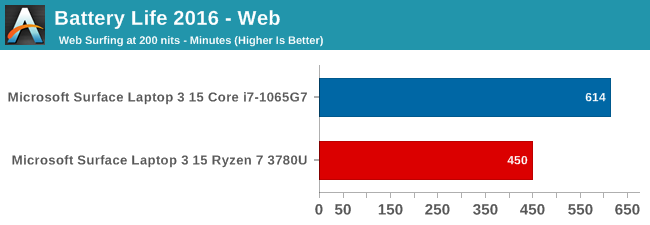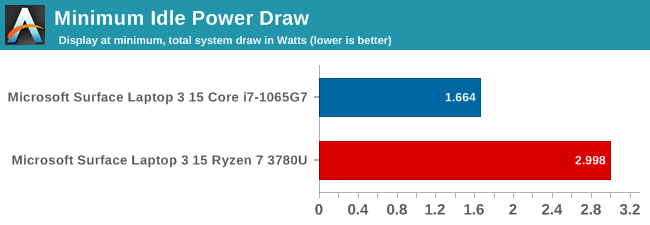The Microsoft Surface Laptop 3 Showdown: AMD's Ryzen Picasso vs. Intel's Ice Lake
by Brett Howse & Andrei Frumusanu on December 13, 2019 8:30 AM ESTPlatform Power
Performance aside, the other side of the coin is battery life. AMD made big gains in battery life with the Ryzen 3000 series, somewhat addressing the power requirements of the platform and getting rid of some of the excessive idle power draw, but they are still using DDR4 on their mobile platform, which puts them at a disadvantage right out of the gate. Intel has made very good gains in battery life over the last several generations, and the move to 10 nm for Ice Lake also brought along LPDDR4X support. Most of the previous generation laptops stuck with LPDDR3, unless the manufacturer needed more than 16 GB of RAM, where they’d be forced to switch to DDR4. Finally adding LPDDR4X support is something that Intel has needed to do for a while, and ironically Intel’s flagship Core product line lagged behind their low-cost Atom lineup which did support LPDDR4.
Web Battery Life

The Ryzen 7 3780U powered Surface Laptop 3 was slightly under the Ryzen 5 device we tested at launch, but still in the same range. The AMD system isn’t helped very much by Microsoft only offering a 46 Wh nominal battery capacity, which is rather undersized for a 15-inch laptop. The Ice Lake device, as we’ve seen before, was much more efficient under load, offering a sizeable battery life lead.
Idle Power
One of AMD’s biggest challenges was to get their laptop SoC into a premium device, and with the Surface Laptop 3 they have succeeded. Microsoft has shown themselves as being adept at squeezing battery life out of devices, with low-power displays, and good internal components to minimize power draw. Here Intel has held a considerable advantage over the last couple of years, and the move to 10 nm should, in theory, help as well.
To test the idle power draw of both systems, the battery discharge rate was monitored with the screens fixed in at 5.35 nits, to minimize the power draw of the display on the result. Normally we’d prefer to have the display completely off for this test, but Microsoft’s power plan on the Surface Laptop actively turns off the laptop when the display times out.

The Ice Lake system was able to go all the way down to right around 2 Watts of power draw – and sometimes slightly under – with as low as 1.7 Watts seen. We’ve seen under 1 Watt of draw on an 8th generation Core Y series processor, and around 1.5 Watts on the same generation U series, so considering the display is not completely off on the Surface Laptop, the 2-Watt draw is quite reasonable.
The Picasso system was not quite as efficient, drawing 3 Watts at idle. This is in-line with the results we’ve seen on other Picasso systems and explains the lower battery life results on the AMD system. AMD made big gains moving from Raven Ridge to Picasso, but I’m sure the team is looking forward to the 7 nm Zen 2 coming to their laptops, which we hope will address this further.










174 Comments
View All Comments
yannigr2 - Saturday, December 14, 2019 - link
Nice. Let's run the single threaded SPEC2017 test to show how good Intel is against the new star, the Ryzen 9 3950.Let's run the multi threaded SPEC2017 test WITHOUT the desktop CPUs to avoid showing how bad Intel is against the Ryzen 9 3950.
yannigr2 - Saturday, December 14, 2019 - link
Thats way we can title both results as "Intel having an advantage"Where is the good old Anandtech?
Brett Howse - Saturday, December 14, 2019 - link
The comparison is 15W AMD to 15W Intel in the same laptop. Please refer to the title of the article.yannigr2 - Sunday, December 15, 2019 - link
Then why are there results from desktop processors ESPECIALLY on the SINGLE threaded performance, but no results on the multi threaded performance?Maybe to advertise the single threaded performance that Ice Lake offers, compared to Zen 2? Maybe because 16 Zen 2 cores obliterate Intel chips on multithreaded tests?
The fact that you avoid in the article to explain why you only post single threaded, but no multithreaded results from desktop processors explains much. Hides nothing.
One "Tom's Hardware" is enough. We don't need another.
Brett Howse - Sunday, December 15, 2019 - link
Because it's relevant on single-threaded but irrelevant on multi-threaded. If you're after desktop CPU reviews we have those as well. If we were going to run SPEC multi-thread on a desktop CPU we'd not be running it at Rate 8. Rate 8 was run on these two processors because they have 8 threads.Maxiking - Saturday, December 14, 2019 - link
Lol, amd trash brigading again.Haawser - Saturday, December 14, 2019 - link
I think 7nm Ryzen mobile will be a lot more competitive than Picasso. Which is 'ok' for a last generation 12nm effort, but unlikely to hold a candle to a 7nm Zen2 APU. So next year should be a really interesting one as far as notebooks are concerned.Cliff34 - Saturday, December 14, 2019 - link
Looking at the price, spec and performance, Intel is still the winner in the laptop areana. Why would anyone save 100 dollars for a laptop that is win home, slower and less battery life?eastcoast_pete - Saturday, December 14, 2019 - link
Two additional comments:1. The Ryzen version is overpriced; as is, it would still be an attractive option if the price would be $300 or so less. Right now, the value proposition is on the side of the Ice Lake i7 version.
2. Many comments here complain about how this comparison is unfair to AMD's APU. Why not complain about AMD not shipping a mobile APU based on Zen2 in 7 nm, preferably with Navi graphics on board, more L3 cache, and LPDDR4 support? Isn't that the likely reason for Ice Lake taking the cake here, and trouncing AMD?
As is, I view the current Ryzen mobile APUs as good choices for mid-level machines suitable for occasional e-sports gaming, not for running a premium ultraportable $ 2000+ laptop.
MBarton - Monday, December 30, 2019 - link
"2. Many comments here complain about how this comparison is unfair to AMD's APU. Why not complain about AMD not shipping a mobile APU based on Zen2 in 7 nm, preferably with Navi graphics on board, more L3 cache, and LPDDR4 support? Isn't that the likely reason for Ice Lake taking the cake here, and trouncing AMD?"Because all Zen 2 production is being channeled into HIGH profit server and HEDT CPU sales. While Intel fans get a moral victory in the Surface 3 review, their 10nm CPU parts are making Intel very little money using a process node they have burned billions trying to get working. AMD doesn't have the convenience of diverting valuable 7nm parts to low margin mobile sales. Congrats to Intel, they've won a much needed but very hollow victory.